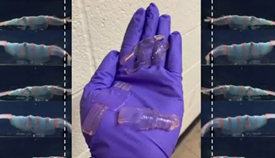GELBOTS

Disclaimer: Copyright infringement not intended.
Context
- In a new study, scientists from Johns Hopkins University have described an inchworm-inspired robot called Gelbot that is powered exclusively by the change in temperature.
Details
- The 'gelbot', the robot shrinks or swells depending on the variation in the temperature of its surroundings. This causes the robot to move in a particular direction without relying on a power source to facilitate its movement.
- This is an object moving without batteries, without wiring, without an external power supply of any kind—just on the swelling and shrinking of gel.
- The gelbot is able to move because of the way its shape, dimensions and patterning of gel are designed. Typically, robots are made almost exclusively of hard materials like metals and plastics, which makes it hard to make more human-like robots, and thus useful for biomedical research.
- Water-based gels, which feel like gummy bears, are believed to be extremely promising materials for soft robotics. They rely on the principle that gels that swell or shrink in response to temperature can be used to create smart structures.
- The swelling and shrinking of gels can be strategically manipulated to move robots forward and backward on flat surfaces, or to have them crawl in certain directions with an undulating, wave-like motion.
- The gelbots, which are still experimental, are created by 3D printing. Produced using gelatine, the robot is powered entirely through the alteration of temperature. Fluctuations in temperature, between 30-60 Celsius, can cause the gelbot to either shrink or swell.
Significance
- Generally, robots are manufactured using hard materials such as plastics and metals. This serves as the primary obstacle in the pursuit of creating robots that are suitable for biomedical applications. However, a subfield of robotics known as soft robotics aims at addressing this challenge.
- The robot may aid in the delivery of drugs to specific organs within the body in the future.
- They could also be deployed as marine robots, patrolling and monitoring the ocean’s surface.
- The use of 3D printing makes the mass production of these robots an easy endeavour.
- Scientists hope to train the gelbots to crawl in response to variations in human biomarkers and biochemicals and test other worm and marine organism-inspired shapes and forms that could be designed to incorporate cameras and sensors on their bodies.



.jpg)
.jpg)
1.png)
